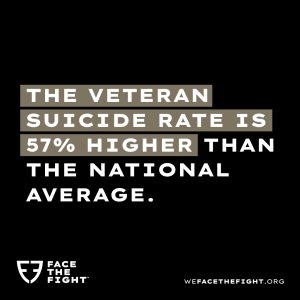 SAN ANTONIO — “You are not in this fight alone.”
SAN ANTONIO — “You are not in this fight alone.”
That’s the message a coalition of business and charitable organizations wants to send veterans struggling with depression and thoughts of suicide. Face the Fight aims to eliminate the stigma of seeking help, increase awareness of the problem, and bring resources to support efforts of the VA and DoD to stop veteran suicide.
“Veteran suicide is a national crisis. An estimated 50,000 more veterans will die by suicide this decade, if we don’t act now,” said Sonya Medina Williams, Reach Resilience president and CEO. “As part of our mission to serve communities and people in crisis, we are committed to Face the Fight with USAA and the Humana Foundation. Together, we will break the silence around veteran suicide and spark a national conversation about military life, mental health and the need for our country to show up for our veterans and ensure that no one is left behind.”
Their first goal: Cut veteran suicide by half by 2030.
The founding members of Face the Fight include the financial services company USAA and the USAA Foundation, the Humana Foundation and Reach Resilience, which have contributed a total of $41 million in seed funding to a philanthropic fund to provide grants to programs addressing veteran suicide. The program is support by most of the major VSOs.
To put the money where it will do the most good, USAA worked with experts from the University of Texas Health Science Center in San Antonio, the VA, the DoD, RAND Corp. and nonprofit groups to develop a philanthropic strategy and metrics for success.
“USAA’s more than 100-year legacy is built on supporting and advocating for the military community,” said Wayne Peacock, USAA president and CEO. “Our servicemembers stand tall in the noble calling to serve others, and we need to stand with them for challenges they may face, including mental health and suicide. Through focused funding and work with experts, we believe Face the Fight will make a difference in raising awareness for veteran suicide prevention. And we invite others to join us in this fight.”
The coalition recognizes that veterans often must overcome barriers to care. “We join this fight to help remove systemic barriers and raise awareness of the mental health challenges faced by our veteran community who have dedicated their lives to serving our country,” said Burce D. Broussard, Humana president and CEO. “Humana is committed to ensuring all veterans and military members have access to the care they need, especially those in underserved communities where advances in health equity are greatly needed.”
Biomarkers Help ID Risk
The systemic efforts of Face the Fight might soon have support at the level of individual veterans and their health teams, thanks to research by Draper Laboratory scientists and their colleagues, who have developed a behavioral health tool to identify veterans and other individuals at risk of suicide. The tool integrates preconscious brain signals with other physiological biomarkers to create an objective way to screen for suicide risk.
“Preconscious neural signals occur between approximately 500 and 750 milliseconds. They represent your brain processing information prior to you being consciously aware or able to filter your response,” said Gretchen Knaack, PhD, a neuroscientist in Draper’s Biosecurity group. “A diagnostic tool that uses preconscious brain signals and physiological biomarkers may provide quantitative information that someone is at risk for suicide, thus enabling clinicians to give treatment earlier and more reliably than ever before.”
The Draper team is working with the Defense Advanced Research Projects Agency (DARPA) to focus on veterans and military personnel, with the goal of identifying signs of depression and suicidal ideation earlier to enable life-saving intervention. DARPA announced the Neural Evidence Aggregation Tool (NEAT) program in 2022. In addition to Draper, the participating researchers come from McLean Hospital and Harvard Medical School, the University of Pennsylvania, Northeastern University and Georgia Tech.
Today, screening for depression and signs of potential self-harm relies on veterans to accurately report how they are feeling, which they may be reluctant to do for fear of appearing weak or unstable.
NEAT aims to aggregate preconscious brain signals to identify what an individual actually believes to be true—not what they want to be true or think the clinician wants them to say. The screening process might include presenting biographical information, actions or intentions, and then using triangulation of the neural and physiological responses to determine whether the person questioned believes the stimuli provided are true, false or indeterminate.
Draper’s focus will be to design, test and refine methods to evoke specific preconscious mental processes. The multimodal approach will include physiological sensors such as electroencephalogram (EEG), electrocardiogram (ECG) and pupillometry, combined with innovations in sensor fusion, signal processing and neural analytics; and use advances in machine learning and data science to aggregate the preconscious responses collected across a set of stimuli into a final measurement that quantifies what a person believes to be true for a specific topic.
“Ultimately, NEAT will provide clinicians with an objective metric for mental health,” said Andrea Webb, PhD, a scientist in Human Centered Solutions at Draper. “We are excited by the potential for NEAT to help assess and treat mental health issues and improve outcomes for those affected by them.”
